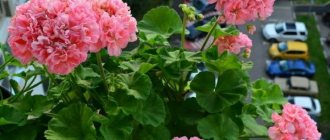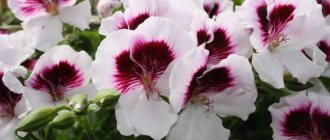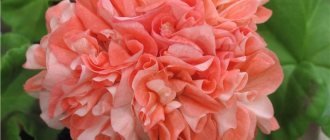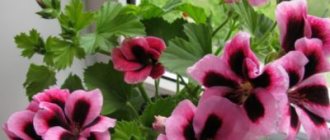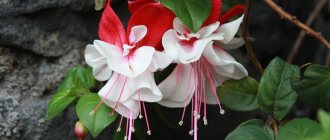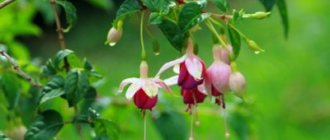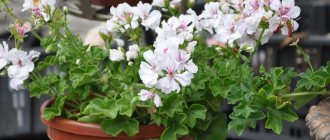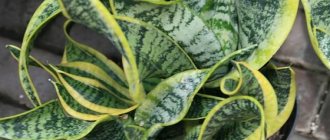Popular varieties
The description of terry pelargonium will be incomplete if we study the key features of the category as a whole. In order for you to be able to clearly decide which varieties you want to root in your own garden plot, be sure to consider their main advantages and characteristics. Only in this case will you select for your flowerbed or garden design those varieties of geraniums that will look harmonious.
Edwards Christina
This pretty compact shrub is covered with flowers that form a dense cap. The buds have a soft pink tint, close to peach, and they are quite voluminous. Providing proper care for the plant at home will not be difficult for you, and flowering Edwards Christina will bring you a lot of pleasure.
Martha
A variety of domestic pelargonium called Martha is a compact domestic shrub. It is covered with white voluminous flowers with slight terry around the edges. The leaves of this plant have a soft green tint. In order for this flower specimen to develop fully, it is very important to place the pot with the sprout in a shaded place. The thing is that such geraniums do not tolerate direct sunlight very well.
South African sun
The South African sun variety of pelargonium is a dwarf variety of this plant. Such a specimen will certainly not go unnoticed on your windowsill. Double flowers of a bright red hue form on the stem. Despite the fact that this variety itself is compact, its branching is not bad, so it will make a lush flowering decoration for your home. The leaves of this geranium have a rich light green tint.
Among the main advantages of this variety, it is worth highlighting first of all the fact that even a novice gardener can form a shrub.
Gardenia
What is good about the Gardenia geranium variety is its aesthetic appearance and versatility. It can be safely grown not only at home, but also in open ground. This variety will become a true decoration for a park area or garden; with its help you can decorate the landscape of your own dacha area.
An elegant plant with white buds blooms for a long time. In this case, one pinching will be enough to form an indoor miniature shrub correctly and soon enjoy the blooming flowers.
Bold rose
The Bold rose pelargonium variety is notable for its bright buds. They are full-color, terry, and also form a dense cap. Caring for such a plant is not difficult; all you need to do is follow the basic recommendations for growing geraniums.
Lara enwoy
The pelargonium variety called Lara enwoy primarily stands out among the entire diversity of the group for its large double flowers. They are painted in salmon color, which harmoniously combines with white. The shrub grows compact, but its stems are quite strong.
This variety of indoor pelargonium is one of the achievements of Australian breeders. Such a floral specimen will look unusual in any gardener’s collection. That is why if you want to have a rare and unusually beautiful variety of geranium, you should give preference to this particular variety.
Geranium and company
But everything said is just a saying. The British, when they introduced geraniums into the garden, probably thought through everything several steps ahead! And they moved this modest inhabitant of meadows and inconveniences to the queen of all flowers - the rose! The color combinations here are generally accepted. Although I have a very calm attitude towards the queen of the garden (apparently, monarchical ideas are not close to me), I am aware that the combination, for example, of a white-flowered rose with pink or red geranium is absolutely a win-win! Roses in soft cream or light yellow shades go well with blue geraniums.
Geranium pirenaicum 'Bill Wallis'
And again, I can’t ignore my favorite geranium ministamen . She has fuchsia flowers. Against its background, light-colored roses will look advantageous. Just remember that this “black-eyed” one is quite tall. And since she still plays the role of a retinue, then, of course, the retinue should not be higher than their mistress. And white geraniums! They will perfectly set off the depth of dark red roses. In short, geraniums and roses are absolutely the right decision! To this company, perhaps, it is worth adding soft mantle and oak sage - fortunately, a lot of varieties of the latter have been bred. And all this modest trinity - geranium, mantle and sage - are classic rose partners.
Geranium psilostemon 'Patricia'
And in tandem, where the first place rightfully belongs to the rose, and geranium performs only an auxiliary function, there are no problems in special care for geranium. Simply, in the fall, when it’s time to say to our garden: “Goodbye, see you spring!”, we cut off the leaves of deciduous geraniums and do not touch those with winter-green leaves. And we cover the roses, not thinking at all about whether our geranium will like it.
In the spring, after removing the cover from the roses, gardeners are often upset: here part of the bush is propped up, here, on the contrary, it is frozen, and here, damn them, the voles tried their best, ringing the ' Broceliande ' ! Geraniums, despite the damage caused to the lady by the weather and rodents, are ready to once again fulfill the role assigned to them - to be light makeup on a beautiful young face!
As you can see, the use of garden geraniums in garden design is so diverse and multifaceted that it does not impose any restrictions on us. And this plant itself is so flexible that it will fit “in any yard” and will be in place everywhere.
Andrey Ganov, St. Petersburg
Growing rules
Even the most popular varieties of home geranium (Country, Desert, Gogodansaren, Warrenorth, Vastanbyn, Madame bowary) are not considered whimsical. However, key tips for caring for them are worth remembering if you want to encourage long-term flowering in your specimen.
First of all, the temperature in the room where your home flower is located should not fall below +10 °C. Place the potted plant in a west or east window as the lighting there is never too bright. If your flower specimen always stays on the south window, it is advisable to shade it on hot summer days.
Be sure to take care to saturate the plants with complex fertilizers from time to time. Watering should be moderate, and the presence of drainage holes in the flowerpot is mandatory.
Whatever varieties of geranium you prefer to root in your home (Black, Blue, Jacqui caws, Jagershus, Orange, Pleasure, Rubbelitte, Dessert, Madame, Orange, Powder Pouf, etc.), caring for them will not be difficult even for a beginner . But the result will certainly impress both you and your guests.
myorchidea.ru
Description and characteristics of cultivation
Interestingly, among all the variety of varieties, it is dwarf geranium that is becoming increasingly popular. It has many advantages. For example, such a plant will take its rightful place on the windowsill and fit perfectly into any of your flower collections.
It is grown in a compact pot, since the flower is very miniature. Nevertheless, its small dimensions do not prevent it from blooming magnificently. Another important advantage of this group of geraniums is that formative pruning of such a flower specimen is not necessary at all.
Caring for dwarf pelargonium varieties at home is not too labor-intensive; even a beginner can handle it. However, take some recommendations into account so as not to harm your indoor flowers. For example, like most geraniums, dwarf pelargonium does not like waterlogged soil - it will cause the rhizome to rot before you even blink an eye. That's why remember two things:
- The plant substrate should be moistened in moderation;
- The soil must contain sand or vermiculite. Such components are useful because they absorb excess moisture, and you do not have to correct the consequences of waterlogging the soil.
You will certainly be able to care for low-growing varieties of pelargonium. Over time, many gardeners begin to expand their collection of dwarf geraniums. This can be done easily and at home, no extra costs will be required.
How are these flowers propagated? It is best to start this procedure at the end of February or early March. It is during this period that the plant gradually comes to its senses after wintering, and its vital processes are activated. First of all, cut the cutting with two internodes, and then dry it thoroughly.
The next stage is planting in nutrient soil. It is not recommended to cover the top of the cutting with glass or film - this will only create an excessively humid environment for the geranium, which can have a detrimental effect on it. Miniature cuttings of pelargonium will very quickly take root in a new place. The main thing is to place the pot with the shoots in a well-lit place. Under favorable conditions, within a month you will receive a fully rooted plant.
Of course, you can’t do without transplanting homemade miniature geraniums. This procedure is not performed very often. If you notice that the flower has grown sufficiently, and, most likely, there is no longer enough space for the rhizome in the mini-pot, you can place it in a slightly larger pot. But don’t overdo it: if you plant a plant in a flowerpot that is too large, it may simply die, because the root system will not fill the bottom of the container, and without this the flower will not begin to develop.
In order for pelargonium varieties Dovepoint or pelargonium Barnstondale to delight you with its lush and long-lasting flowering, you need to take care of this yourself. You can't do without feeding. Nutrient mixtures can be added to the substrate a month after planting the plant in its permanent place.
Purchase either universal nutritional formulations or special fertilizers for homemade geraniums. You should not neglect feeding the flowers, since if there is a deficiency of organic and mineral substances in the soil, the plant may suffer from chlorosis or blackleg (fungal disease).
What needs to be done before sowing pelargonium: preparation stages
By the time of sowing, you need to prepare all the equipment. A lot depends on correctly selected seeds, containers, and soil, so it’s useful to know all the nuances. Let's talk about this in more detail.
How to select and prepare seeds
Of course, you cannot sow a crop without seed material. Therefore, before the procedure, you need to select geranium seeds with suitable characteristics. Fortunately, now on sale you can find a wide variety of different varieties and hybrids of pelargonium, which differ in size, color, etc. You can even buy special varieties of geranium that are most suitable for growing in open ground.
When purchasing, it is advisable to give preference to manufacturers who have a good reputation and have proven themselves in the market. Also be sure to check the expiration date, it should not be expired. The seeds themselves must be intact, without signs of damage or mold or fungi.
To see seedlings faster, it is recommended to perform pre-sowing treatment of pelargonium seeds. Since the seeds of this crop have a rather hard shell, it is useful to carry out scarification (that is, breaking the integrity of the seed shell).
To scarify, you just need to grind the pelargonium seeds with sandpaper. The main thing is to do this carefully so as not to spoil the planting material.
Note! When purchasing pelleted or already scarified seeds, there is no need to process them! The manufacturer has already taken care of this.
What container to plant in?
It is important not only what you sow, but also where. It is convenient to sow pelargonium seeds in a wide general container having a height of about 6-8 centimeters (no more). For example, you can buy a special container for seedlings, or you can use a food container or some clean plastic container. The main thing is to make small holes (drainage holes) at the bottom of the planting container, which are necessary to remove excess moisture.
The best varieties
There are more and more new varieties of pelargonium. That is why it is worth considering the most remarkable specimens. Only this way can you make an informed choice and purchase plants that will certainly decorate your home. Among the popular dwarf species of pelargonium, the following varieties are distinguished:
- pelargonium variety Jinky. The advantage of this plant is considered to be large double flowers of a light creamy color. At the same time, at the very core, the petals acquire a rich pink color. This plant is very tender and airy, its foliage is characterized by the presence of a light green tint;
- pelargonium variety Pink Ice. This dwarf bush is quite stocky and branchy for its small size. Its petals are elongated, double, and have a soft pink tint;
- pelargonium variety Clatterbridge. This plant belongs to the group of zonal dwarf geraniums. This shrub is also miniature in size, but blooms intensely. Its flowers are double, bright red;
- Silk Moira. This pelargonium has salmon-colored flowers. This plant is not picky in its care, and it is not difficult to form;
- Madame Maleron. If all previous varieties of pelargonium were distinguished by the presence of bright inflorescences, then this variety does not bloom at all. Its main advantage is its beautiful dark green leaves with a light border;
- Pac Harmony. The flowers of this plant are quite large, semi-double, and have a rich pink color;
- Only Joss. The key advantage of this specimen is the presence of bright, berry-red flowers. There is a slight light inclusion in the center of the bud;
- Deacon Santan. The shrub grows quite compact. However, large bright orange flowers will not leave anyone indifferent;
- Dylan Sharon. What is notable about this dwarf geranium is the presence of dots on the petals of the plant. In addition, such geranium blooms quite intensively;
- Marie-Louise. This dwarf flower is often called a tulip. And all because its buds do not open completely during flowering. The shade of the plant’s petals is very beautiful - soft peach with a transition to creamy;
- Diana Palmer. Another mini-shrub, ready to delight you with intense flowering. The shape of its petals resembles a carnation.
grow-me.ru
Types and varieties of pelargonium
PElargonium (Pelargonium), which most of our compatriots know under the name geranium (Geranium), is a truly amazing indoor plant. Under certain conditions, zonal pelargonium, as well as large-flowered (royal), ampelous forms bloom almost all year round with large and colorful inflorescences. Currently, many species and varieties of these plants have been obtained. Add. For information about pelargonium (geranium) and its varieties, see a separate page...
- Pelargoniums are not geraniums!
- And a red geranium in a pot...
In the last century, a lot of breeding work was carried out to develop numerous hybrids and varieties of pelargonium. Variegated plants were obtained, dwarf forms, varieties with white and two-color, as well as double flowers were bred.
There are still discrepancies in the division of pelargoniums into groups of varieties among the world's leading experts. The most common classification of pelargonium cultivars:
- Zonal, or “standing” ones.
- Ivy-leaved, or balcony.
- Noble grandiflora (royal).
- Angels.
- Uniques.
- Fragrant with small and inconspicuous flowers, but their carved drooping leaves allow the plants to be grown as ornamental foliage. The selection of a group of fragrant ones is conditional, because it may include wild species and unique species.
- There is a group of variegated varieties that differ from ordinary ones in the non-uniform coloring of the leaves. The most variegated ones are among the zonal pelargoniums, but there are also ivy-leaved and fragrant ones with multi-colored foliage.
Pelargonium Jagershus Mormor Marta
Plants with this shipping deadline are sent out from April 1 to May 30 in the order in which orders are received.
Plants with only one delivery date !
For all planting material
Dozens of payment methods
Fast and convenient delivery
Russian Post (Moscow and region within 24 hours), SDEK, Courier
Pelargonium Jagershus Mormor Marta (Jagershus Mormor Mrta).
Dwarf zonal pelargonium. The flowers are double, very beautifully shaped, with tints of color from greenish to pale pink. The bush needs formative pruning.
Classification of pelargoniums by variety groups
Division into groups of varieties according to the Hazel Kay system from the English nursery Fibrex (colloquial terminology is given in brackets):
- Single Zonal pelargoniums. Distinguished by a wide range of flower colors and a single-row arrangement of petals, these varieties are extremely unpretentious.
- Terry zonal (“terry”) - Double Zonal pelargoniums. Developed by crossing P. zonale with inquinans, they have a wide range of colors; When propagated, seeds do not always retain maternal characteristics.
- Rose -bud Zonal pelargoniums. This species is very common and loved all over the world. Its flowers look like a bouquet of roses, hence the name. The inflorescences are gathered so closely around the peduncle that they cannot even open completely.
- Miniature zonal (“miniatures”, “minks”) - Miniature Zonal pelargoniums - miniature bushes compared to other zonal varieties; have different color shades of flowers, and foliage of different colors.
- Dwarf zonal (“dwarfs”) - Dwarf Zonal pelargoniums - are distinguished by their short stature and abundant flowering bushes of various color shades.
- Variegated zonal (“variegated”, “variegated”) - Variegated, Colored, Fancy-leaved pelargoniums. They are also called “fantasy leaf pelargonium” because of the many interesting leaves in structure and color.
- Stellar zonal (“stellar”, “stellar”) - Stellar Zonal pelargoniums - these small varieties are loved for their unusual leaf shape (toothed leaves in the shape of splayed fingers) and for the star shape of the flowers. The leaves are of different colors, and the flowers have a wide range of colors.
- Cactus-flowered Zonal pelargoniums . The difference between these plants is that their petals are similar in flowering to the petals of flowering cactus dahlias.
- Royal pelargoniums (“queens”, “royal”) - Regal pelargoniums are one of the most spectacular, exquisite large-flowered pelargoniums.
- Ivy-leaved pelargoniums (“ivy-leaved”, “buns”) - Ivy-leaved pelargoniums. Ivy is translated from English as “ivy”, hence the name “ivy-leaved”.
- “Ivy” hybrids (“ivy-hybrids”) - Hybrid-Ivy-leaved pelargoniums are the result of crossing zonal and ivy-leaved pelargoniums.
- Fragrant varieties (“fragrant”) - Scented-leaved pelargoniums - have truly amazing aromas and are unique among other species.
- Angels (“Angels”) - Angel pelargoniums, or, as they are also called, violas, because of their pansy-like flowers, they are one of the most popular plants in the genus.
- Unicums (“Uniques”) - Unique pelargoniums are a group of hybrids bred on the basis of royal pelargoniums and have high decorative quality. The leaves of these plants are dissected, have a spicy scent, and the flowers are similar to those of royal pelargonium.
- Species pelargoniums (“species”) - Species pelargoniums - constitute a very diverse and large group of plants. About 250 species of pelargonium are known, most of which are native to South Africa. These plants are beautiful and amazing.
- Species hybrids (“species hybrids”) - Species Hybrids pelargoniums - they amaze with an amazing variety of shapes, sizes, colors of flowers and leaves.
Tulip-shaped varieties are not separated into a separate group; Hazel Kay includes them in her catalog in the section of terry pelargoniums...
Group of fragrant pelargoniums (Pelargonium odoratissimum)
Fragrant geranium, which makes up a special group, has amazing properties. This species includes perennial plants with highly branched light green stems, quite tall (up to 1 m). The leaves are green, palmately lobed with uneven wavy lobes; the whole plant is slightly pubescent. Fragrant pelargonium flowers are small, mostly pink or pinkish-violet, collected in umbrellas, with carved drooping leaves. Numerous varieties of fragrant geraniums have been created, differing in the shade of smell and color of the petals. Fragrant pelargonium is very unpretentious to growing conditions and grows well even on northern windows, but is a little prone to stretching, so timely pinching is necessary.
In addition to its decorative advantages, fragrant pelargonium has significant phytoncidal properties and improves the health of the air in the rooms where it is grown. Thanks to essential oils, they are widely used in medicine, perfumery, and cooking. Among the fragrant species there are plants with the scent of lemon, rose, lemon balm, mint, orange, and apple. The smell is amazing and very strong, just a light touch on the leaf is enough for a pleasant aroma to hover in the air, and your hands will smell until you wash them with soap... (see “Fragrant types of geraniums”)
Pelargonium roseum (Pelargonium roseum) A perennial subshrub with dense, heavily dissected dark green leaves at the edges. Its flowers are small, pinkish (it blooms very rarely), the leaves have a pronounced odor. Rose geranium is originally from America; it is not found in the wild here; it is grown at home as an ornamental plant and cultivated (for oil) in the Crimea, the Caucasus, and Central Asia. Geranium is used for medicinal purposes.
- Essential oil of fragrant geranium
- Indoor geranium in herbal medicine
Beautifully flowering large-flowered pelargoniums
Beautifully flowering plants include large-flowered, zonal and ivy-leaved pelargoniums. The leaves are wide, rounded, beautifully drooping and of various shapes. The flowers are brightly colored, large, simple semi-double or double, collected at the ends of the branches into an inflorescence - an umbrella. The color of the flowers is varied, from white to dark crimson. Flowering depending on the species from spring to late autumn. Zonal pelargoniums are distinguished by smaller flowers and a border of different shades on the leaves. Ivy-leaved geraniums have the smallest flowers; they are grown as hanging plants.
Royal Pelargonium (Pelargonium Regal) Other names: large-flowered hybrid pelargonium; English pelargonium (Pelargonium grandiflorum hybridum hort.). They can also be found under the names French, domestic (Pelargonium x domesticum). The more popular name is Royal or Martha Washington Pelargonium. In the USA this group is called Lady Washington. They were first brought to England, where they were grown since the 17th century and where a large number of their varieties were created.
These plants fully live up to their name - they are truly royalty in the world of pelargoniums! One of the most spectacular, exquisite flowering domestic pelargoniums, but at the same time the most demanding in terms of growing conditions. They are luxurious and more capricious than many other species: they bloom only in the second year after rooting of the cuttings, they require special conditions for wintering, their flowering is limited to three to four months, and you cannot plant them in the front garden.
It has an erect, slightly branched stem with sharp-lobed, folded, finely toothed leaves along the edges. Large-flowered indoor pelargonium produces large flowers (up to 5 cm in diameter), simple and double, with a wide range of colors: from white to dark red with a purple tint. Some varieties have dark spots or dark veins on the petals.
In order for it to bloom more abundantly and longer, in winter for 2-3 months it needs a temperature in the range of 11-13°C with good lighting and short daylight hours. Water very sparingly in winter. In March-April, the plants are transplanted into a fresh soil mixture consisting of turf, leaf soil, peat and sand (1: 1: 1: 2). After transplantation, watering is increased, the temperature is raised to 20°C and they begin to regularly feed with mineral fertilizers twice a month. In spring and summer, plants are placed in well-lit, sunny windows. Propagated in spring by cuttings.
Pelargonium Jagershus Mormor Marta
Plants with this shipping deadline are sent out from April 1 to May 30 in the order in which orders are received.
Plants with only one delivery date !
For all planting material
Dozens of payment methods
Fast and convenient delivery
Russian Post (Moscow and region within 24 hours), SDEK, Courier
Pelargonium Jagershus Mormor Marta (Jagershus Mormor Mrta).
Dwarf zonal pelargonium. The flowers are double, very beautifully shaped, with tints of color from greenish to pale pink. The bush needs formative pruning.
Planting pelargonium: Even a novice gardener can plant pelargonium in the garden - the process does not require compliance with any complex rules. You just need to remember about the long roots of the plant when digging holes about 20 cm deep. When planting, it is better to leave a distance of 20-30 cm between the bushes.
Caring for pelargonium: Pelargonium requires systematic moderate watering: the soil should not be allowed to dry out or there should be a large amount of moisture in the soil. The flower does not need spraying. Garden varieties of pelargonium do well in partial shade; flowering is weak in direct sunlight. Therefore, on particularly hot days, darkening is required. The optimal air temperature for garden plants is no more than +20 °C.
Soil for planting: Pelargonium Jagershus Mormor Marta (Jagershus Mormor Mrta) is quite demanding on the soil. The ideal solution is unused, loose soil with good drainage. For young plants without a formed root system, light soil is more suitable, so sand and peat, vermiculite and perlite are added to the composition. The soil for planting must be sufficiently fertile and well-drained. Pelargonium should not be planted in loamy and clayey soils.
Preparing for winter: Already in the fall, the pot with the plant is placed in a cool and dimly lit place. A southern or northern window sill in a house/apartment is quite suitable for this, since there is diffused sunlight there. And to make up for the lack of light at this time, you can use fluorescent lamps. The optimal daylight hours are 12 hours.
Planting location: The ideal location in the garden for pelargonium Jagershus Mormor Marta (Jagershus Mormor Marta) would be sunny areas. However, even in partial shade it is able to fully develop and bloom profusely throughout the season.
Pelargonium zonale
Other names: hybrid p. and garden p. Zonal pelargonium, known as "geranium" is one of the most popular indoor crops. Many varieties grow well indoors, and many are grown in the garden. Their leaves are decorative, but pelargoniums are especially valued for their beautiful flowers of various colors. The flowers, varied in color and number of petals, are collected in numerous hemispherical umbrellas on long leafless peduncles. Zonal pelargonium, like fragrant pelargonium, can bloom on northern windows, but the flowering will be weak.
The name “zonal” (in Greek zona - “belt”) arose because of the pattern in the form of a stripe of a darker color on the sheet and repeating its shape. This type of pelargonium first appeared as a potted crop in Europe at the beginning of the 18th century. Its varieties were obtained as a result of repeated crossings of zonal pelargonium (P. zonale L'Herit.) with other species and forms. Now they can be found in almost every home. Very undemanding to growing conditions. All zonal pelargoniums bloom profusely from early spring to late autumn. But to do this, they need to be grown in a cramped container with nutritious soil, kept in a sunny window, watered abundantly and fed regularly. In winter, plants are placed in a cool place and watered less often, once or twice a week.
If you do not have the opportunity to provide the plant with a cool room, then at the beginning of spring the indoor plant is severely pruned, removing all bare and elongated shoots. Then transplant into a fresh soil mixture of turf soil (or compost soil), humus, peat and sand (1:1:1:2) and begin to water it abundantly and regularly apply mineral fertilizers twice a month.
Pelargoniums from seeds
- Pelargonium seeds on sale!
of hybrid zonal pelargoniums in stores.
— hybrids (First generation) of the first generation (F1) and second generation (F2), from which compact, unpretentious plants grow, blooming profusely.
Depending on the size of the bush and inflorescence, pelargoniums grown from seeds are divided into two groups:
- multiflora - with low, compact and abundantly flowering bushes, resistant to rain and wind, grows well in balcony and window boxes, in garden flowerpots and flower beds
- grandiflora - taller bushes, bloom less profusely, but have very large flowers and inflorescences, ideal for bouquets
Pelargonium with ivy leaves
Ivy-leaved pelargoniums are usually used as hanging plants. These are shrubs with branched drooping stems. The leaves resemble ivy leaves in appearance - five-lobed, entire, fleshy, glossy. The flowers are collected in umbrellas of several pieces: white, pink, purple. Varieties have been bred with leaves edged with white stripes and variegated flowers.
Pelargonium peltatum This type of geranium comes from the coastal regions of South Africa. A plant with drooping green leafy shoots and beautiful inflorescences in pink and red tones. Blooms throughout summer and early autumn. This is an excellent material for outdoor vertical landscaping of verandas, lobbies, balconies, windows and for indoor use. Pelargonium thyroid propagates by herbaceous cuttings, mainly in spring. By pinching and trimming it is given the desired shape. Grows well on a mixture of leaf, turf, humus soil and sand (2:2:2:1). In winter, it is kept at a temperature of 15-17°C. To have the most spectacular plants that grow in all directions, you should plant two or even three rooted cuttings in a pot. Young plants are replanted annually in spring. Can be damaged by aphids and spider mites.
Miniature pelargonium Elmfield in Moscow
- Address: Moscow
Rooted cuttings of miniature star pelargonium. It has dark green, jagged foliage and beautiful, medium-sized red flowers with white streaks. The plant is unpretentious.
Share Show on map Complain
Unfortunately, this advertisement is no longer relevant. You can see similar current advertisements from the current category a little lower, or go to the category using the link: Indoor flowers and plants in the city of Moscow. You can also use the site search form.
Ficus benjamina, 14 years old. Size 1.6. Home-grown in Stupino, pick-up
Moscow city – Indoor flowers and plants
I’m selling an orchid from my collection, I took it as a butterfly 2000, but blossomed this one 1500
Moscow city – Indoor flowers and plants
Gorgeous monstera The leaves of this variety are large, the larger the surface, the more oxygen. This variety is grown in ordinary apartments, offices, or in a country house. It serves as a kind of barometer, this one.
Moscow city – Indoor flowers and plants
I sell dwarf sansevieria in a plastic pot. Another name is mother-in-law's tongue. Color: snakeskin. It will not grow higher, it will spread out the rosette. The plant is mature - 3 years old, has given birth to two children. The plant belongs to.
Moscow city – Indoor flowers and plants
Varietal hibiscus, rooted, sending. photo 1-2 Voodoo Magic-1500 rubles photo 3 Voodoo Magic-1000 rubles photo 4-5 Tsunami-1000 rubles photo 6-7 Taiwan Magical Piano -1300 rubles photo 8-9 Zoye -1200 rubles
Moscow city – Indoor flowers and plants
An adult plant for the winter garden.
Moscow city – Indoor flowers and plants
Moscow city – Indoor flowers and plants
An interesting variety of milkweed, for example, its branches have thorns, for which the plant received the name “crown of thorns”. The plant is more than 10 years old. The height of the plant is 84 cm, if the branches are straightened.
Moscow city – Indoor flowers and plants
violets, white pink purple and blue, they don’t bloom now and I don’t remember which one where, I’ll give them all for 300 each for 100
Moscow city – Indoor flowers and plants
Height 1 m 20 cm. Pickup from Mayakovskaya.
Moscow city – Indoor flowers and plants
Succulent Pelargoniums
There are a number of attractive succulent species. Their place of origin is South Africa and the Mediterranean. The stems are often curved, woody at the base, thickened, and sometimes prickly, which makes the plant decorative. The leaves are usually deciduous, with seasonal abscission, which is typical in the summer for most species. Many leaves have a strong aroma.
Plants are sensitive to frost and are grown in sunny areas, but must be protected from direct sunlight. Propagated by seeds or cuttings in spring. They use soil with a significant admixture of sand or broken bricks.
This type is used when creating compositions in the bonsai style, decorating interiors, and landscaping rocky gardens. The most popular varieties are humpback (P. gibbosum L'Herit), cortusleaf (P. cortusaefolium L'Herit), fleshy (P. carnosum L'Herit.).
www.florets.ru
